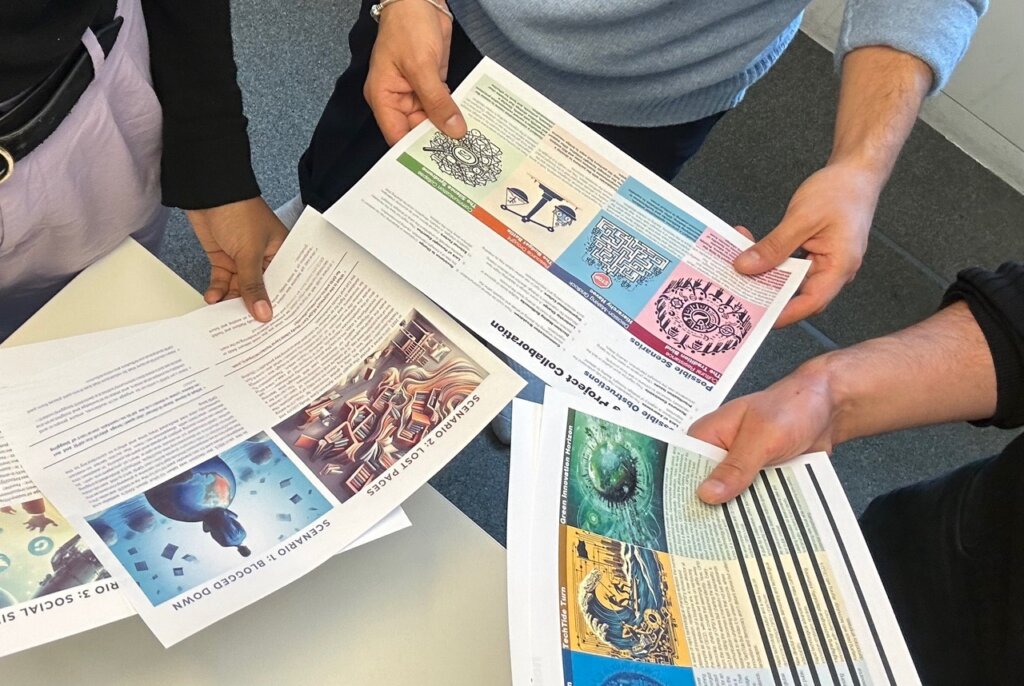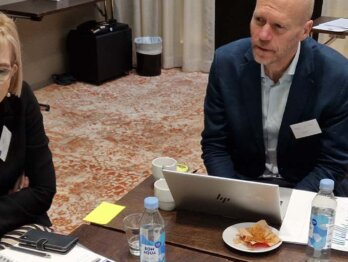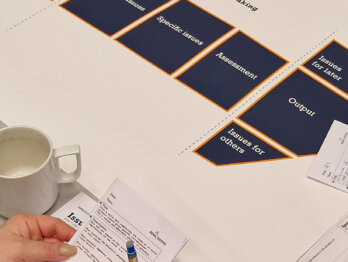Instant Scenarios: How to fast-forward your foresight and skip straight to strategy

When I was young, my parents resisted getting a microwave oven, believing it would encourage us to eat unhealthy and poor-quality food. It wasn’t until years later, when a friend actually bought them a microwave, that they relented, and started benefiting from the quick-fix cuisine it offers. They haven’t abandoned proper pots and pans, but they’ve found a way for tradition and expedience to coexist.
Fast forward to today, and there’s a similar shift happening in strategic foresight. Just as my parents found a balance between old and new ways of cooking, today’s futurists are navigating the intersection of time-honoured methods and the revolutionary speed and efficiency offered by artificial intelligence. In parallel, the OECD’s broader work on governing with AI is focusing on the deployment and use of AI in the public sector.
In this article, my colleague Claire and I discuss our recent experiments in using AI as an innovative way to craft scenarios for public sector challenges. We walk you through our experience, so you can try it for yourself, and bring some impressive and valuable fuel for conversation to your next strategy meeting.

Imagine going into your next strategy meeting equipped with scenarios prepared in a flash!
This article is for experienced futurists. It is not a beginner’s guide to strategic foresight or scenario planning. It delves into experimental and unproven techniques, aiming to help experts apply and elevate their skills. We bypass the basic principles. We assume you have a strong understanding of what goes into this type of scenarios, and a clear idea of your desired outcomes. AI writes for you; it doesn’t think for you. Without a solid grasp of the discipline, you risk getting bogged down in nonsense.
AI writes for you; it doesn’t think for you
If you’re new to strategic foresight, we recommend bringing in experts. You can also consult resources like Futures and Foresight in the OPSI Toolkit Navigator, the publications of the OECD Strategic Foresight Unit, and this advice on getting the most from publicly available scenarios.
Why we needed scenarios fast
Claire and I both recently found ourselves preparing for strategy-type meetings, in which we needed to discuss unknown and uncertain future changes. Claire’s was about preparing a communications strategy in a shifting organisational context. Mine was about planning a research programme with a partner institution facing political change.
Each of us realised that we had an incomplete picture of the future, which made it hard to know if we were making the right decisions. This was the first step: we needed to define the purpose of the exercise. It was to highlight where we had imperfect information, and to support internal dialogue on how to make our work a success.
Next, we needed to determine which elements to explore. This second step was thus to map all the relevant players and factors in our strategic environment. This included:
- Our own organisation, activities, and objectives
- Players in our transactional environment like senior decision-makers and partner organisations
- Factors in our contextual environment like cybersecurity and the outcome of elections
It was important to separate out these three things: the value of the exercise was to test how we would act in a world we didn’t expect or choose.
Why we decided to try AI
By this point we had already spent about half the time available for our scenario-building, but we had only laid the foundations.
The next step would be to gather all the elements in our mapping, explore how they could change (predictions, forecasts, and weak signals), and imagine how they could interact to create different and disruptive future contextual environments. This horizon scanning is crucial to strategic foresight, because it imagines how the future could diverge from the present in surprising and significant ways. The step after that would be to craft story-like descriptions of those future contextual environments. Stories are one of the key strengths of scenarios: they help humans to make sense of complexity, retain important facts, and question decisions.
We had minutes, not weeks
These last two steps would normally be a weeks-long process involving research, surveys, workshops, analysis, reports, and review. We had minutes, not weeks. So instead of slow-cooking these scenarios, we decided to microwave them. Enter AI.
The warning label
Before we go further, let’s consider the limitations. Generative AI tools process input text, read the context and content, and then serve up responses. They don’t possess reason, wisdom, or objectives. They don’t know how the world works. They don’t conduct research or analysis. They reproduce text patterns learned during training.
The division of skills was clear then: we humans did the analytical, critical, and strategic thinking; and then tasked machines with transforming our messy mapping of the strategic environment into something mentally digestible.
Here are the precautions we took:
- Understand that things can go wrong: this is an experimental approach, so results can be weird, unpleasant, or just useless. Ever had something explode, burn, or boil over in a microwave? Imagine having to do the scenario equivalent of that clean-up job.
- Manage expectations: scenarios generated this way are going to be less carefully prepared, so potentially lower quality and less beneficial. This is fast-food foresight, so don’t expect gourmet quality.
- Have fun, but keep focus: as with human-crafted scenarios, it can be tempting to wander off into all kinds of interesting tangents, but if you don’t have the luxury of time then it is important to stick to what is going to serve your purpose.
- Make it easy for the machines, make it easy for the humans: remember this is supposed to be a time-saving exercise. Avoid over-complication in what you put in and get out.
This is fast-food foresight, so don’t expect gourmet quality
- Use appropriately: the outputs might be adequate for informal, internal discussions among critical colleagues who know that scenarios are only and always fictional. But without thorough review, they wouldn’t meet the standards of truth, analysis, and objectivity required for trustworthy official publications.
- Maintain ethics and confidentiality: the outputs of this exercise should promote dialogue about ethical actions, not supplant it. Check principles on safe and ethical use of AI, and adhere to any rules and guidelines that apply.
- Disclose generative AI use: uphold the highest standards of transparency by indicating where and how generative AI has been used in your work.
- Check for biases: AI can sometimes reproduce patterns of thinking that deserve criticism, including some forms of prejudice. Scenarios are supposed to reveal and challenge assumptions, not reinforce them.

How we made them: a prompt-by-prompt guide to creating strategic foresight scenarios using AI
Below we list the prompts we used, along with the rationale and some tips to help you make it the AI work better.
The word ‘user’ refers to the organisation, team, or individual whose strategic dialogue will be guided by the scenarios.
It is important to give feedback to each response generated by the AI. If anything is missing or incorrect, say so before issuing the next prompt.
Prompt 1
Study this background information:
- My organisation is [user]: [description of the user’s objectives and activities]
- Here is our transactional environment: [description of the key relevant players]
- Here is our contextual environment: [description of the key relevant factors]
Prompt 1 introduces the AI to the user’s contextual environment. This information isn’t immediately acted upon, but the model may regurgitate a summary, which you can check for accuracy and give feedback on.
Prompt 2
Write a list of the most important objectives for [user]’s strategy
In prompt 2 we are testing the AI’s understanding of the core goals and aspirations that will guide and shape the user’s future planning and actions. These objectives should be aligned with the user’s specific needs and values. Give the model feedback.
Prompt 3
Write a list of the most important hypothetical future changes in the transactional environment that could plausibly disrupt or redirect the objectives in [user]’s strategy
Prompt 3 explores potential future changes in the transactional environment. You can add a timeframe here if that’s important to you. In your feedback, top up the list generated with predictions, forecasts, and weak signals from your own horizon scanning if you have them.
Prompt 4
Write a list of the most surprising and impactful hypothetical political, economic, technological, social, or environmental future changes in the contextual environment that could plausibly disrupt or redirect the objectives in [user]’s strategy
Prompt 4 extends the exploration into the contextual environment. You can add a timeframe here if that’s important to you. In your feedback, top up the list generated with predictions, forecasts, and weak signals from your own horizon scanning if you have them.
Prompt 5
Combine elements of the above answers into four contrasting, coherent story-scenarios of a fictional future context in which [user] could find itself. For each story-scenario, describe the situation in the transactional environment, in the contextual environment, and how it affects [user]’s objectives. Give each story-scenario a catchy-name.
Prompt 5 engages the AI in weaving together elements from the preceding steps to craft scenarios. Check if you want all four; your feedback might call for one to be dropped. Check also for hallucinations and politically sensitive ideas, but remember: scenarios are intentionally fictional; unbelievable things happen all the time; and the future doesn’t care if it disrupts, embarrasses, or even destroys your organisation and its beliefs.
Prompt 6
For each story-scenario write a list of two key questions raised that [user] should ask itself now when developing its strategy.
Prompt 6 gets you started on bridging the gap between future foresight and present actions.
Prompt 7
Now produce a table using the above information, with each story-scenario as a column. First row is a three-sentence summary of the main ideas of the story-scenario. Second row is the main transactional changes. Third row is main contextual (political, economic, technological, social, or environmental) changes. Fourth row is opportunities for [user]. Fifth row is threats for [user]. Sixth row is how [user]’s activities might have to change. Seventh row is row is strategic questions for today to help [user] prepare.
Prompt 7 gets you started on presenting the information in a structured and concise way. This visual aid serves as a quick reference for you to use in a briefing document.
How we used them
Scenarios on their own have no value; it is the learning they promote and the decisions they inform that count. The most important consideration for us was how we would use the scenarios.
One idea was to summarise them in a briefing note to provide context and insights ahead of a strategy meeting. Another was to use them in a presentation as conversation-starters in a workshop. Another was to create handouts or posters with the scenarios and key questions to structure and guide creative exchanges for innovation.
These are just the start: futurists could consider integrating AI-generated scenarios into numerous other approaches including persona-building, design fiction, Futures Literacy Labs, or Experiential Futures.
Even with AI, humans still played a vital role in our process of generating and using scenarios. There’s no substitute for in-depth research, critical analysis, or strategic thinking. We also believe that human-generated scenarios have unique value, particularly in settings where the creation process itself is beneficial for the reflection and engagement it fosters.
Even with AI, humans still played a vital role
For us, the most important takeaway here is that we were able to bring strategic foresight to situations where it would normally be too time-consuming and costly. We’ve said before that a little strategic foresight goes a long way. Thanks to new tools, we can now make foresight go even further, faster.
Help us learn more!
Are you considering trying the steps in this article? We’d like to hear from you so we can continue learning from experience. Write an email to [email protected] with the subject ‘Instant Scenarios’, and tell us how it went.
We used AI to help brainstorm ideas and improve language and readability for parts of this article.











